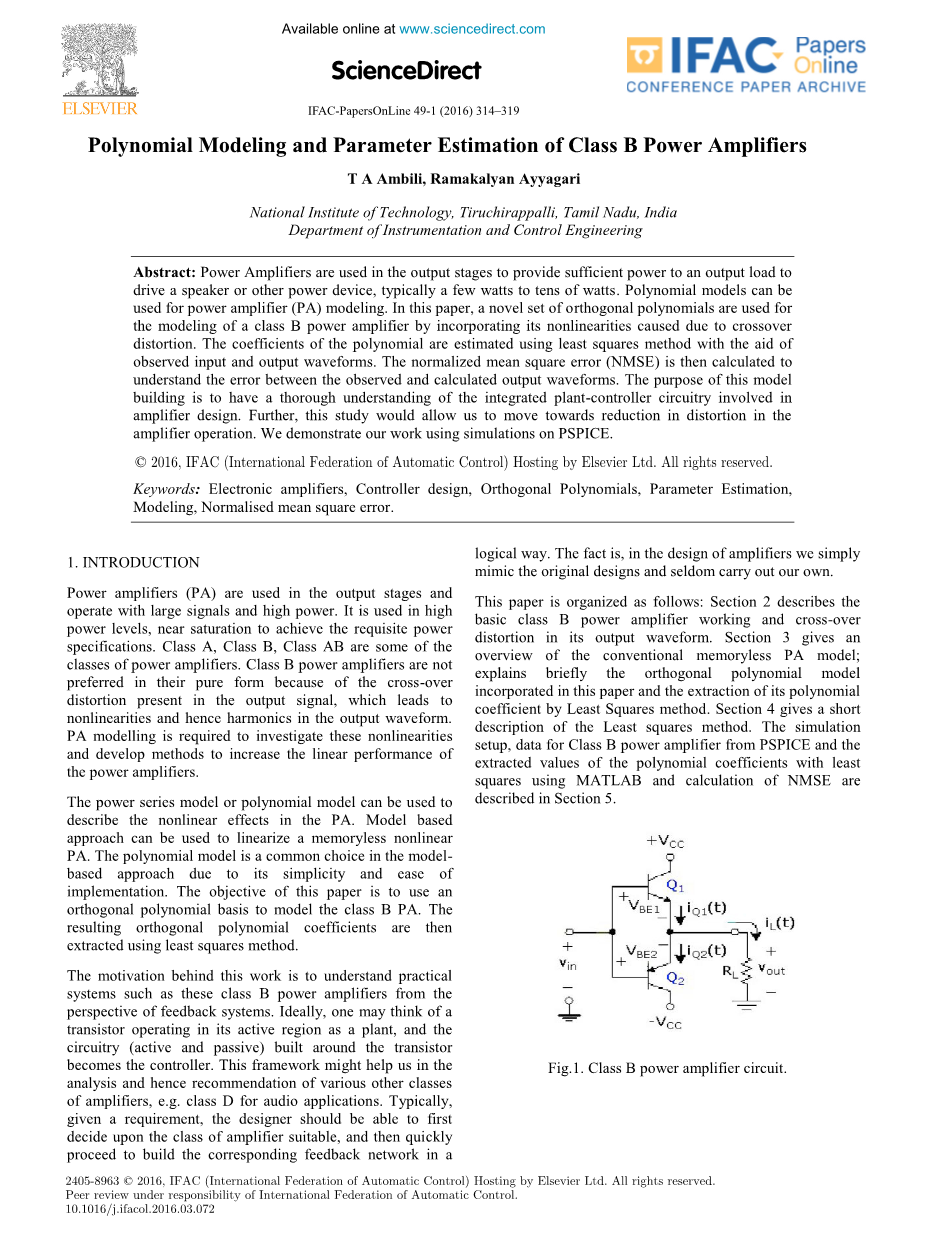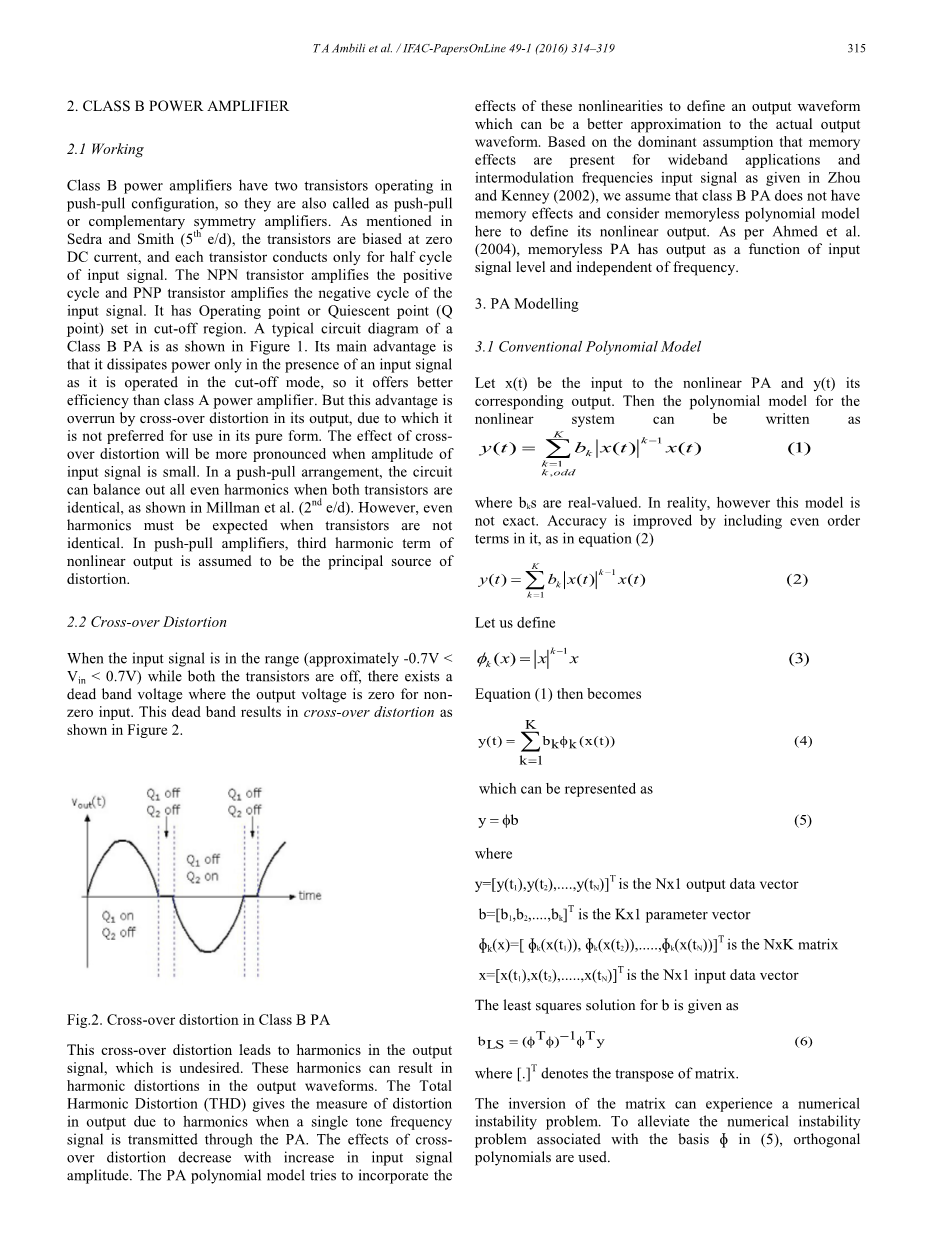放大器非线性失真分析仪的设计与实现外文翻译资料
2022-08-08 11:56:59


英语原文共 6 页,剩余内容已隐藏,支付完成后下载完整资料
Available online at www.sciencedirect.com
ScienceDirect
IFAC-PapersOnLine 49-1 (2016) 314–319
Polynomial Modeling and Parameter Estimation of Class B Power Amplifiers
T A Ambili, Ramakalyan Ayyagari
National Institute of Technology, Tiruchirappalli, Tamil Nadu, India Department of Instrumentation and Control Engineering
Abstract: Power Amplifiers are used in the output stages to provide sufficient power to an output load to drive a speaker or other power device, typically a few watts to tens of watts. Polynomial models can be used for power amplifier (PA) modeling. In this paper, a novel set of orthogonal polynomials are used for the modeling of a class B power amplifier by incorporating its nonlinearities caused due to crossover distortion. The coefficients of the polynomial are estimated using least squares method with the aid of observed input and output waveforms. The normalized mean square error (NMSE) is then calculated to understand the error between the observed and calculated output waveforms. The purpose of this model building is to have a thorough understanding of the integrated plant-controller circuitry involved in amplifier design. Further, this study would allow us to move towards reduction in distortion in the amplifier operation. We demonstrate our work using simulations on PSPICE.
copy; 2016, IFAC (International Federation of Automatic Control) Hosting by Elsevier Ltd. All rights reserved.
Keywords: Electronic amplifiers, Controller design, Orthogonal Polynomials, Parameter Estimation, Modeling, Normalised mean square error.
- INTRODUCTION
Power amplifiers (PA) are used in the output stages and operate with large signals and high power. It is used in high power levels, near saturation to achieve the requisite power specifications. Class A, Class B, Class AB are some of the classes of power amplifiers. Class B power amplifiers are not preferred in their pure form because of the cross-over distortion present in the output signal, which leads to nonlinearities and hence harmonics in the output waveform. PA modelling is required to investigate these nonlinearities and develop methods to increase the linear performance of the power amplifiers.
The power series model or polynomial model can be used to describe the nonlinear effects in the PA. Model based approach can be used to linearize a memoryless nonlinear PA. The polynomial model is a common choice in the model- based approach due to its simplicity and ease of implementation. The objective of this paper is to use an orthogonal polynomial basis to model the class B PA. The resulting orthogonal polynomial coefficients are then extracted using least squares method.
The motivation behind this work is to understand practical systems such as these class B power amplifiers from the perspective of feedback systems. Ideally, one may think of a transistor operating in its active region as a plant, and the circuitry (active and passive) built around the transistor becomes the controller. This framework might help us in the analysis and hence recommendation of various other classes of amplifiers, e.g. class D for audio applications. Typically, given a requirement, the designer should be able to first decide upon the class of amplifier suitable, and then quickly proceed to build the corresponding feedback network in a
logical way. The fact is, in the design of amplifiers we simply mimic the original designs and seldom carry out our own.
This paper is organized as follows: Section 2 describes the basic class B power amplifier working and cross-over distortion in its output waveform. Section 3 gives an overview of the conventional memoryless PA model; explains briefly the orthogonal polynomial model incorporated in this paper and the extraction of its polynomial coefficient by Least Squares method. Section 4 gives a short description of the Least squares method. The simulation setup, data for Class B power amplifier from PSPICE and the extracted values of the polynomial coefficients with least squares using MATLAB and calculation of NMSE are described in Section 5.
Fig.1. Class B power amplifier circuit.
2405-8963 copy; 2016, IFAC(International Federation of Automatic Control) Hosting by Elsevier Ltd. All rights reserved. Peer review under responsibility of International Federation of Automatic Control.
10.1016/j.ifacol.2016.03.072
T A Ambili et al. / IFAC-PapersOnLine 49-1 (2016) 314–319 315
-
CLASS B POWER AMPLIFIER
- Working
Class B power amplifiers have two transistors operating in push-pull configuration, so they are also called as push-pull or complementary symmetry amplifiers. As mentioned in Sedra and Smith (5th e/d), the transistors are biased at zero DC current, and each transistor conducts only for half cycle of input signal. The NPN transistor amplifies the positive cycle and PNP transistor amplifies the negative cycle of the input signal. It has Operating point or Quiescent point (Q point) set in cut-off region. A typical circuit diagram of a Class B PA is as shown in Figure 1. Its main advantage is that it dissipates power only in the presence of an input signal as it is operated in the cut-off mode, so it offers better efficiency than class A power amplifier. But this advantage is overrun by cross-over distortion in its output, due
剩余内容已隐藏,支付完成后下载完整资料
资料编号:[258041],资料为PDF文档或Word文档,PDF文档可免费转换为Word




